Blog
High School Sports and Foot Injuries
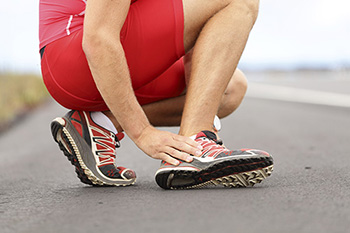
In high school sports, basketball, soccer, and track are among the top activities causing foot injuries. Basketball involves sudden stops, jumps, and pivots, leading to sprained ankles, stress fractures, and plantar fasciitis. Soccer players, constantly changing direction and coming into contact with other players, are prone to ankle sprains, toe injuries, and heel pain. In track and field, high-impact running, jumping, and repeated pressure on the feet often result in stress fractures, shin splints, and Achilles tendinitis. Injuries happen from overuse, poor conditioning, inadequate footwear, or sudden, intense movements. Prevention includes wearing proper footwear for the sport, warming up effectively, and gradually building strength and flexibility in the feet and ankles. If a foot or ankle injury occurs in your teen child, it is suggested that you visit a podiatrist for an accurate diagnosis and structured treatment plan.
Ankle and foot injuries are common among athletes and in many sports. They can be caused by several problems and may be potentially serious. If you are feeling pain or think you were injured in a sporting event or when exercising, consult with Dr. Tupper from Coshocton Foot Health Center. Our doctor will assess your condition and provide you with quality foot and ankle treatment.
Common Injuries
The most common injuries that occur in sporting activities include:
- Achilles Tendonitis
- Achilles Tendon Rupture
- Ankle Sprains
- Broken Foot
- Plantar Fasciitis
- Stress Fractures
- Turf Toe
Symptoms
Symptoms vary depending upon the injury and in some cases, there may be no symptoms at all. However, in most cases, some form of symptom is experienced. Pain, aching, burning, bruising, tenderness, tightness or stiffness, sensation loss, difficulty moving, and swelling are the most common symptoms.
Treatment
Just as symptoms vary depending upon the injury, so do treatment options. A common treatment method is known as the RICE method. This method involves rest, applying ice, compression and elevating the afflicted foot or ankle. If the injury appears to be more serious, surgery might be required, such as arthroscopic or reconstructive surgery. Lastly, rehabilitation or therapy might be needed to gain full functionality in the afflicted area. Any discomfort experienced by an athlete must be evaluated by a licensed, reputable medical professional.
If you have any questions, please feel free to contact our office located in Coshocton, OH . We offer the newest diagnostic and treatment technologies for all your foot care needs.
Pros and Cons of Ankle Fusion Surgery
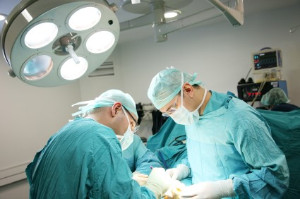
Ankle fusion surgery, also known as ankle arthrodesis, involves fusing the bones in the ankle to alleviate chronic pain, often caused by severe arthritis. By removing damaged cartilage and stabilizing the bones with screws or other hardware, this surgery eliminates joint movement while reducing pain significantly. However, the resulting lack of joint mobility may affect activities that require flexibility in the ankle. Benefits of ankle fusion surgery include substantial pain relief and potential reduction in the need for pain medications. However, long-term risks include altered gait mechanics, increased stress on surrounding joints, and the possibility of complications like infection or bone healing issues. Also, recovery from fusion surgery often requires weeks of immobilization and exercises to restore strength and functionality. A podiatrist can evaluate whether ankle fusion surgery is suitable for you, guide your recovery, and manage complications or biomechanical adjustments. If you have chronic ankle pain, it is suggested that you make an appointment with a podiatrist.
Ankle pain can have many different causes and the pain may potentially be serious. If you have ankle pain, consult with Dr. Tupper from Coshocton Foot Health Center. Our doctor will assess your condition and provide you with quality foot and ankle treatment.
Ankle pain is any condition that causes pain in the ankle. Due to the fact that the ankle consists of tendons, muscles, bones, and ligaments, ankle pain can come from a number of different conditions.
Causes
The most common causes of ankle pain include:
- Types of arthritis (rheumatoid, osteoarthritis, and gout)
- Ankle sprains
- Broken ankles
- Achilles tendinitis
- Achilles tendon rupture
- Stress fractures
- Tarsal tunnel syndrome
- Plantar fasciitis
Symptoms
Symptoms of ankle injury vary based upon the condition. Pain may include general pain and discomfort, swelling, aching, redness, bruising, burning or stabbing sensations, and/or loss of sensation.
Diagnosis
Due to the wide variety of potential causes of ankle pain, podiatrists will utilize a number of different methods to properly diagnose ankle pain. This can include asking for personal and family medical histories and of any recent injuries. Further diagnosis may include sensation tests, a physical examination, and potentially x-rays or other imaging tests.
Treatment
Just as the range of causes varies widely, so do treatments. Some more common treatments are rest, ice packs, keeping pressure off the foot, orthotics and braces, medication for inflammation and pain, and surgery.
If you have any questions, please feel free to contact our office located in Coshocton, OH . We offer the newest diagnostic and treatment technologies for all your foot care needs.
The Pros and Cons of Exercising Barefoot

Exercising barefoot has both benefits and potential drawbacks. One of the main advantages is that it helps strengthen the muscles in the feet and lower legs, improving balance and posture. Without the cushioning of shoes, the feet engage more, potentially leading to better proprioception and increased foot mobility. Barefoot workouts can also improve overall foot alignment and reduce the risk of certain injuries, such as ankle sprains. However, there are also some downsides. Exercising without shoes can increase the risk of cuts, bruises, or other foot injuries, especially when performing activities on hard or uneven surfaces. It can also put additional stress on the joints, particularly for individuals with pre-existing foot conditions like flat feet or plantar fasciitis. If you have injured your foot while exercising, it is suggested that you consult a podiatrist who can offer you effective treatment solutions, in addition to guiding you on exercising barefoot.
Exercising your feet regularly with the proper foot wear is a great way to prevent injuries and build strength. If you have any concerns about your feet, contact Dr. Tupper from Coshocton Foot Health Center. Our doctor can provide the care you need to keep you pain-free and on your feet.
Exercise for Your Feet
Exercise for your feet can help you gain strength, mobility and flexibility in your feet. They say that strengthening your feet can be just as rewarding as strengthening another part of the body. Your feet are very important, and we often forget about them in our daily tasks. But it is because of our feet that are we able to get going and do what we need to. For those of us fortunate enough to not have any foot problems, it is an important gesture to take care of them to ensure good health in the long run.
Some foot health exercises can include ankle pumps, tip-toeing, toe rises, lifting off the floor doing reps and sets, and flexing the toes. It is best to speak with Our doctor to determine an appropriate regimen for your needs. Everyone’s needs and bodies are different, and the activities required to maintain strength in the feet vary from individual to individual.
Once you get into a routine of doing regular exercise, you may notice a difference in your feet and how strong they may become.
If you have any questions please feel free to contact our office located in Coshocton, OH . We offer the newest diagnostic and treatment technologies for all your foot and ankle needs.
Causes and Symptoms of Turf Toe

Turf toe is an injury that affects athletes who perform sudden, powerful movements that bend the big toe upward beyond normal range. Pushing off to sprint, jump or move forward in a football or basketball game are common ways that turf toe develops. This action can strain or tear the ligaments and soft tissues surrounding the big toe joint, leading to pain, swelling, and limited movement. Athletes who play on artificial turf are particularly at risk due to the harder, less absorbent surface, though turf toe can also affect dancers, gymnasts, and wrestlers. Footwear with flexible soles can contribute to the risk of turf toe, as it provides less stability during rapid movements. Symptoms may range from mild pain and slight swelling to more severe cases involving ligament rupture and long-lasting joint stiffness. A podiatrist can prescribe a walking boot or other orthotic device to limit joint movement. Surgery, though rare, may be needed in more stubborn or severe cases. If you have a turf toe injury, it is suggested that you schedule an appointment with a podiatrist for an exam and treatment.
Toe pain can disrupt your daily activities. If you have any concerns, contact Dr. Tupper of Coshocton Foot Health Center. Our doctor can provide the care you need to keep you pain-free and on your feet.
What Causes Toe Pain?
Most severe toe pain is caused due to a sports injury, trauma from dropping something heavy on the toe, or bumping into something rigid. Other problems can develop over time for various reasons.
Toe pain can be caused by one or more ailments. The most common include:
- Trauma
- Sports injury
- Wearing shoes that are too tight
- Arthritis
- Gout
- Corns and calluses
- Hammertoe
- Bunions
- Blisters
- Ingrown toenails
- Sprains
- Fractures (broken bones)
- Dislocations
When to See a Podiatrist
- Severe pain
- Persistent pain that lasts more than a week
- Signs of infection
- Continued swelling
- Pain that prevents walking
Diagnosis
In many cases the cause of toe pain is obvious, but in others, a podiatrist may want to use more advanced methods to determine the problem. These can range from simple visual inspections and sensation tests to X-rays and MRI scans. Prior medical history, family medical history, and any recent physical traumatic events will all be taken into consideration for a proper diagnosis.
Treatment
Treatments for toe pain and injuries vary and may include shoe inserts, padding, taping, medicines, injections, and in some cases, surgery. If you believe that you have broken a toe, please see a podiatrist as soon as possible.
If you have any questions please feel free to contact our office located in Coshocton, OH . We offer the newest diagnostic tools and technology to treat your foot and ankle needs.
Repairing an Achilles Tendon Injury
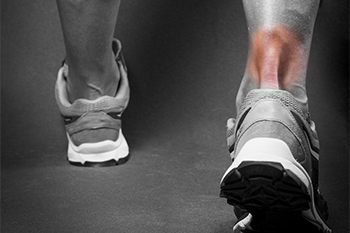
The Achilles tendon connects the calf muscles to the heel bone. It enables essential foot movements like pointing the toes and pushing off when walking or running. Achilles tendon injuries often result from intense physical activities, such as sudden acceleration, landing hard on the heel, or stepping onto an uneven surface. If the tendon ruptures, surgery may be necessary to restore functionality. During the procedure, a podiatrist carefully brings the tendon ends together and sutures them to promote proper healing. However, non-surgical treatments are sometimes effective, particularly for partial tears, and involve structured rehabilitation methods to encourage recovery. Potential risks from surgical repairs include infection, nerve damage, scarring, or even re-injury, underscoring the importance of having a podiatrist assess the condition and provide guidance on the best approach. With proper care, most people regain significant mobility and strength in the affected foot. If you have injured your Achilles tendon, it is suggested that you schedule an appointment with a podiatrist for treatment.
Achilles tendon injuries need immediate attention to avoid future complications. If you have any concerns, contact Dr. Tupper of Coshocton Foot Health Center. Our doctor can provide the care you need to keep you pain-free and on your feet.
What Is the Achilles Tendon?
The Achilles tendon is a tendon that connects the lower leg muscles and calf to the heel of the foot. It is the strongest tendon in the human body and is essential for making movement possible. Because this tendon is such an integral part of the body, any injuries to it can create immense difficulties and should immediately be presented to a doctor.
What Are the Symptoms of an Achilles Tendon Injury?
There are various types of injuries that can affect the Achilles tendon. The two most common injuries are Achilles tendinitis and ruptures of the tendon.
Achilles Tendinitis Symptoms
- Inflammation
- Dull to severe pain
- Increased blood flow to the tendon
- Thickening of the tendon
Rupture Symptoms
- Extreme pain and swelling in the foot
- Total immobility
Treatment and Prevention
Achilles tendon injuries are diagnosed by a thorough physical evaluation, which can include an MRI. Treatment involves rest, physical therapy, and in some cases, surgery. However, various preventative measures can be taken to avoid these injuries, such as:
- Thorough stretching of the tendon before and after exercise
- Strengthening exercises like calf raises, squats, leg curls, leg extensions, leg raises, lunges, and leg presses
If you have any questions please feel free to contact our office located in Coshocton, OH . We offer the newest diagnostic tools and technology to treat your foot and ankle needs.
Are You Suffering From Ingrown Toenails?
Risk Factors and Signs of Gout

Gout is a form of inflammatory arthritis characterized by sudden and debilitating pain, swelling, and redness in the joints, often affecting the big toe. This condition arises from elevated levels of uric acid in the blood, leading to the formation of urate crystals in the joints. Several risk factors can increase the likelihood of developing gout, including a diet high in purines, which are found in foods such as red meat, shellfish, and alcohol. Obesity, certain medical conditions like hypertension and diabetes, and a family history of gout also contribute to risk. Common signs of gout include intense joint pain, particularly during the night, and tenderness or discomfort in the affected area. If you have had one or more gout episodes, it is suggested that you are under the care of a podiatrist who can help you to manage this condition.
Gout is a foot condition that requires certain treatment and care. If you are seeking treatment, contact Dr. Tupper from Coshocton Foot Health Center. Our doctor will treat your foot and ankle needs.
What Is Gout?
Gout is a type of arthritis caused by a buildup of uric acid in the bloodstream. It often develops in the foot, especially the big toe area, although it can manifest in other parts of the body as well. Gout can make walking and standing very painful and is especially common in diabetics and the obese.
People typically get gout because of a poor diet. Genetic predisposition is also a factor. The children of parents who have had gout frequently have a chance of developing it themselves.
Gout can easily be identified by redness and inflammation of the big toe and the surrounding areas of the foot. Other symptoms include extreme fatigue, joint pain, and running high fevers. Sometimes corticosteroid drugs can be prescribed to treat gout, but the best way to combat this disease is to get more exercise and eat a better diet.
If you have any questions please feel free to contact our office located in Coshocton, OH . We offer the newest diagnostic and treatment technologies for all your foot and ankle needs.
Recognizing Symptoms of Poor Foot Circulation
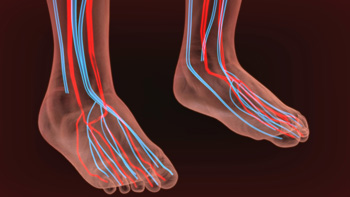
Poor foot circulation can lead to a range of concerning symptoms that may significantly impact your daily life. Common indicators include numbness, tingling, or a cold sensation in the feet. Individuals may also experience cramping, especially during physical activity, and slow-healing wounds or ulcers. Several underlying causes can contribute to poor circulation, including varicose veins, peripheral artery disease, atherosclerosis, and blood clots. Varicose veins can impede blood flow due to weakened valves, while peripheral artery disease restricts blood supply to the extremities. Atherosclerosis, caused by a buildup of fatty deposits in arteries, can further diminish circulation. Blood clots can obstruct blood flow entirely, causing severe complications. If your feet are affected by poor circulation, it is suggested that you consult a podiatrist for a comprehensive treatment plan.
Poor circulation is a serious condition and needs immediate medical attention. If you have any concerns with poor circulation in your feet contact Dr. Tupper of Coshocton Foot Health Center. Our doctor will treat your foot and ankle needs.
Poor Circulation in the Feet
Poor blood circulation in the feet and legs is can be caused by peripheral artery disease (PAD), which is the result of a buildup of plaque in the arteries.
Plaque buildup or atherosclerosis results from excess calcium and cholesterol in the bloodstream. This can restrict the amount of blood which can flow through the arteries. Poor blood circulation in the feet and legs are sometimes caused by inflammation in the blood vessels, known as vasculitis.
Causes
Lack of oxygen and oxygen from poor blood circulation restricts muscle growth and development. It can also cause:
- Muscle pain, stiffness, or weakness
- Numbness or cramping in the legs
- Skin discoloration
- Slower nail & hair growth
- Erectile dysfunction
Those who have diabetes or smoke are at greatest risk for poor circulation, as are those who are over 50. If you have poor circulation in the feet and legs it may be caused by PAD and is important to make changes to your lifestyle in order to reduce risk of getting a heart attack or stroke. Exercise and maintaining a healthy lifestyle will dramatically improve conditions.
As always, see a podiatrist as he or she will assist in finding a regimen that suits you. A podiatrist can also prescribe you any needed medication.
If you have any questions please feel free to contact our office located in Coshocton, OH . We offer the newest diagnostic and treatment technologies for all your foot and ankle needs.
Have Swollen Feet During Pregnancy?

Foot swelling, or edema, is a common occurrence during pregnancy, often resulting from increased fluid retention and hormonal changes. As the body prepares for childbirth, the growing uterus puts pressure on the blood vessels in the pelvis, which can impede circulation and lead to swollen feet and ankles. To find relief, pregnant women should elevate their feet whenever possible, stay well-hydrated, and wear supportive footwear. Gentle foot stretches can also improve circulation, and simple exercises like ankle rotations and toe stretches help promote blood flow. Additionally, taking regular breaks to walk around can alleviate discomfort. If your feet have become swollen during your pregnancy and you are experiencing worsening discomfort, it is suggested that you visit a podiatrist for treatment.
Pregnant women with swollen feet can be treated with a variety of different methods that are readily available. For more information about other cures for swollen feet during pregnancy, consult with Dr. Tupper from Coshocton Foot Health Center. Our doctor will attend to all of your foot and ankle needs.
What Foot Problems Can Arise During Pregnancy?
One problem that can occur is overpronation, which occurs when the arch of the foot flattens and tends to roll inward. This can cause pain and discomfort in your heels while you’re walking or even just standing up, trying to support your baby.
Another problem is edema, or swelling in the extremities. This often affects the feet during pregnancy but tends to occur in the later stages.
How Can I Keep My Feet Healthy During Pregnancy?
- Wearing orthotics can provide extra support for the feet and help distribute weight evenly
- Minimize the amount of time spent walking barefoot
- Wear shoes with good arch support
- Wear shoes that allow for good circulation to the feet
- Elevate feet if you experience swelling
- Massage your feet
- Get regular, light exercise, such as walking, to promote blood circulation to the feet
If you have any questions please feel free to contact our office located in Coshocton, OH . We offer the newest diagnostic and treatment technologies for all your foot and ankle needs.
Causes and Concerns Related to Tingling in the Feet
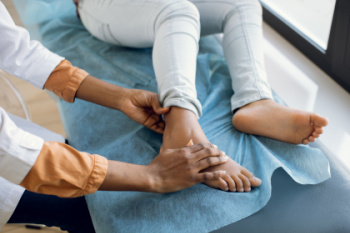
Tingling feet, often described as a pins-and-needles sensation, can arise from several underlying conditions. Diabetes is a major contributor, as high blood sugar levels can lead to diabetic neuropathy, which affects nerve function in the extremities. Multiple sclerosis is another condition that may cause tingling due to nerve damage affecting communication between the brain and body. Peripheral artery disease, or PAD, resulting in narrowed arteries, can reduce blood flow to the feet, leading to abnormal sensations. Kidney failure may also result in neuropathy caused by the accumulation of toxins in the body, affecting nerve health. Additionally, alcoholic neuropathy is a consequence of excessive alcohol consumption, damaging peripheral nerves. If you have developed this sensation in your feet, it is suggested that you consult a podiatrist who can offer you effective relief and treatment solutions.
Foot Pain
Foot pain can be extremely painful and debilitating. If you have a foot pain, consult with Dr. Tupper from Coshocton Foot Health Center. Our doctor will assess your condition and provide you with quality foot and ankle treatment.
Causes
Foot pain is a very broad condition that could be caused by one or more ailments. The most common include:
- Bunions
- Hammertoes
- Plantar Fasciitis
- Bone Spurs
- Corns
- Tarsal Tunnel Syndrome
- Ingrown Toenails
- Arthritis (such as Gout, Rheumatoid, and Osteoarthritis)
- Flat Feet
- Injury (from stress fractures, broken toe, foot, ankle, Achilles tendon ruptures, and sprains)
- And more
Diagnosis
To figure out the cause of foot pain, podiatrists utilize several different methods. This can range from simple visual inspections and sensation tests to X-rays and MRI scans. Prior medical history, family medical history, and any recent physical traumatic events will all be taken into consideration for a proper diagnosis.
Treatment
Treatment depends upon the cause of the foot pain. Whether it is resting, staying off the foot, or having surgery; podiatrists have a number of treatment options available for foot pain.
If you have any questions, please feel free to contact our office located in Coshocton, OH . We offer the newest diagnostic and treatment technologies for all your foot care needs.
More...
Wounds That Don't Heal Need to Be Checked
A Brief Overview of Congenital Foot Deformities
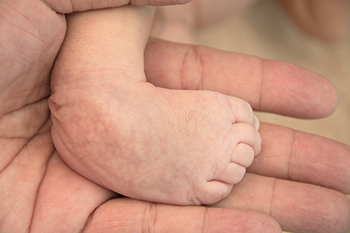
Congenital foot deformities encompass a range of conditions that affect the structure and function of the feet from birth. Metatarsus adductus is characterized by an inward curve of the front of the foot, while clubfoot appears as a twisted position that may require intervention. Polydactyly involves the presence of extra toes, adding complexity to foot development. Another condition, congenital vertical talus, results in a rigid flat foot that can impact mobility if not treated early. Congenital curly toes refer to toes that curl under, which may cause discomfort or difficulties in walking. While these deformities can vary in severity, early diagnosis and appropriate treatment are essential for promoting healthy foot function and mobility. If your child suffers from a congenital foot deformity, it is suggested that you see a podiatrist who can prescribe the correct treatment and provide essential management tips.
Congenital foot problems require immediate attention to avoid future complications. If you have any concerns, contact Dr. Tupper of Coshocton Foot Health Center. Our doctor can provide the care you need to keep you pain-free and on your feet.
Congenital foot problems are deformities affecting the feet, toes, and/or ankles that children are born with. Some of these conditions have a genetic cause while others just happen. Some specific foot ailments that children may be born with include clubfeet, polydactyly/macrodactyly, and cleft foot. There are several other foot anomalies that can occur congenitally. What all of these conditions have in common is that a child may experience difficulty walking or performing everyday activities, as well as trouble finding footwear that fits their foot deformity. Some of these conditions are more serious than others. Consulting with a podiatrist as early as possible will help in properly diagnosing a child’s foot condition while getting the necessary treatment underway.
What are Causes of Congenital Foot Problem?
A congenital foot problem is one that happens to a child at birth. These conditions can be caused by a genetic predisposition, developmental or positional abnormalities during gestation, or with no known cause.
What are Symptoms of Congenital Foot Problems?
Symptoms vary by the congenital condition. Symptoms may consist of the following:
- Clubfoot, where tendons are shortened, bones are shaped differently, and the Achilles tendon is tight, causing the foot to point in and down. It is also possible for the soles of the feet to face each other.
- Polydactyly, which usually consists of a nubbin or small lump of tissue without a bone, a toe that is partially formed but has no joints, or an extra toe.
- Vertical talus, where the talus bone forms in the wrong position causing other bones in the foot to line up improperly, the front of the foot to point up, and the bottom of the foot to stiffen, with no arch, and to curve out.
- Tarsal coalition, when there is an abnormal connection of two or more bones in the foot leading to severe, rigid flatfoot.
- Cleft foot, where there are missing toes, a V-shaped cleft, and other anatomical differences.
- Macrodactyly, when the toes are abnormally large due to overgrowth of the underlying bone or soft tissue.
Treatment and Prevention
While there is nothing one can do to prevent congenital foot problems, raising awareness and receiving neonatal screenings are important. Early detection by taking your child to a podiatrist leads to the best outcome possible.
If you have any questions please feel free to contact our office located in Coshocton, OH . We offer the newest diagnostic tools and technology to treat your foot and ankle needs.
Medical Causes and Symptoms of Swollen Feet
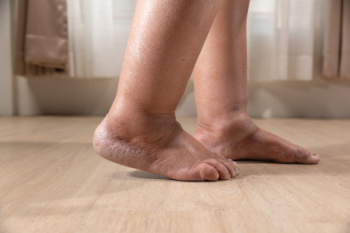
Foot swelling, medically known as edema, occurs when excess fluid accumulates in the tissues of the feet. This condition can arise from various medical reasons, including heart failure, kidney disease, and venous insufficiency, where blood flow is impaired. It can also result from injuries, infections, or certain medications. Symptoms of foot swelling include noticeable puffiness, increased circumference of the foot, and discomfort or tightness in the affected area. In some cases, the swelling may be accompanied by pain or difficulty in movement. Identifying the underlying cause is vital for effective treatment and management. If your feet have become swollen, it is suggested that you confer with a podiatrist who can determine the cause and offer relief and treatment options.
Swollen feet can be a sign of an underlying condition. If you have any concerns, contact Dr. Tupper of Coshocton Foot Health Center. Our doctor can provide the care you need to keep you pain-free and on your feet.
Swollen feet are a common ailment among pregnant women and people who stand or sit for extended periods. Aging may increase the possibility of swollen feet and patients who are obese often notice when their feet are swelling too. There may be medical reasons why swollen feet occur:
- Phlebitis - A condition that causes the veins to become inflamed and can also cause leg pain.
- Liver disease - This may lead to low blood levels of albumin which is a protein. This can cause fluid in the blood to pass into the tissues and several areas of the body can become swollen.
- Heart failure - When the heart doesn’t pump properly the blood that is normally pumped back to the heart can pool in the veins of the legs causing swollen feet.
- Kidney disease - One of the main functions of the kidneys is releasing excess fluid in the body. This type of condition can make it difficult for the kidneys to function properly, and as a result the feet may become swollen.
- Deep-vein thrombosis (DVT)- This is a serious condition where blood clots form in the veins of the legs. They can block the return of blood from the legs to the heart which may cause the feet to swell. It is important to be treated by a podiatrist if this condition is present.
Swollen feet can also be caused by bone and tendon conditions, including fractures, arthritis, and tendinitis. Additionally, there may be skin and toenail conditions and an infection may cause the feet to swell. Patients who take medicine to treat high blood pressure may be prone to getting swollen feet.
Many patients elevate their feet to help relieve the swelling and this is generally a temporary remedy. When a podiatrist is consulted the reason behind the swelling can be uncovered and subsequently treated.
If you have any questions please feel free to contact our office located in Coshocton, OH . We offer the newest diagnostic tools and technology to treat your foot and ankle needs.
Syndesmosis Injury and Ankle Pain
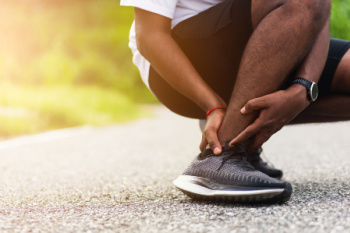
A syndesmosis injury involves the ligament connecting the tibia and fibula, which are the two main bones of the lower leg just above the ankle. This ligament plays a key role in maintaining stability in the ankle joint. Damage often happens when the foot twists outward in relation to the leg, commonly known as an external rotation injury. Syndesmosis injuries typically occur at the same time as ankle sprains or fractures. Symptoms include pain above the ankle, calf pain, and difficulty bearing weight. Proper diagnosis might involve X-rays or advanced imaging techniques to assess the stability of the joint. Severe cases may require surgery to realign and stabilize the joint. A podiatrist can provide both diagnostic clarity and treatment options, from conservative care to surgical intervention. If you have ankle pain related to the ligaments in your lower leg, it is suggested that you make an appointment with a podiatrist for an exam, diagnosis, and treatment options.
Ankle pain can be caused by a number of problems and may be potentially serious. If you have ankle pain, consult with Dr. Tupper from Coshocton Foot Health Center. Our doctor will assess your condition and provide you with quality foot and ankle treatment.
Ankle pain is any condition that causes pain in the ankle. Due to the fact that the ankle consists of tendons, muscles, bones, and ligaments, ankle pain can come from a number of different conditions.
Causes
The most common causes of ankle pain include:
- Types of arthritis (rheumatoid, osteoarthritis, and gout)
- Ankle sprains
- Broken ankles
- Achilles tendonitis
- Achilles tendon rupture
- Stress fractures
- Bursitis
- Tarsal tunnel syndrome
- Plantar fasciitis
Symptoms
Symptoms of ankle injury vary based upon the condition. Pain may include general pain and discomfort, swelling, aching, redness, bruising, burning or stabbing sensations, and/or loss of sensation.
Diagnosis
Due to the wide variety of potential causes of ankle pain, podiatrists will utilize a number of different methods to properly diagnose ankle pain. This can include asking for personal and family medical histories and of any recent injuries. Further diagnosis may include sensation tests, a physical examination, and potentially x-rays or other imaging tests.
Treatment
Just as the range of causes varies widely, so do treatments. Some more common treatments are rest, ice packs, keeping pressure off the foot, orthotics and braces, medication for inflammation and pain, and surgery.
If you have any questions, please feel free to contact our office located in Coshocton, OH . We offer the newest diagnostic and treatment technologies for all your foot care needs.


